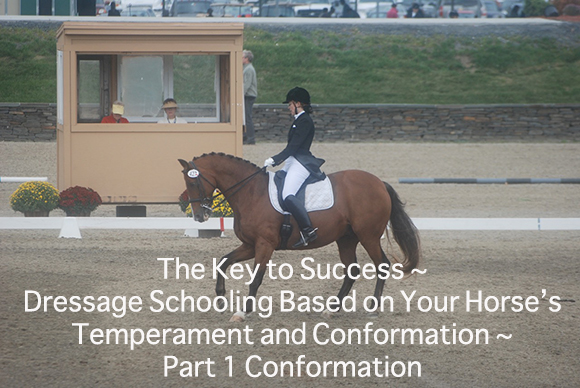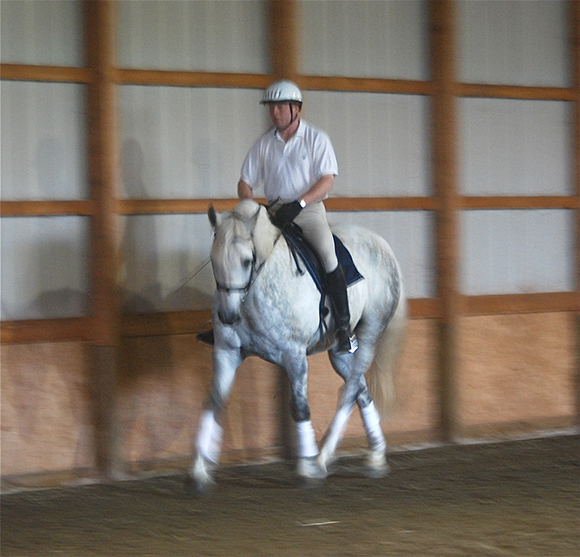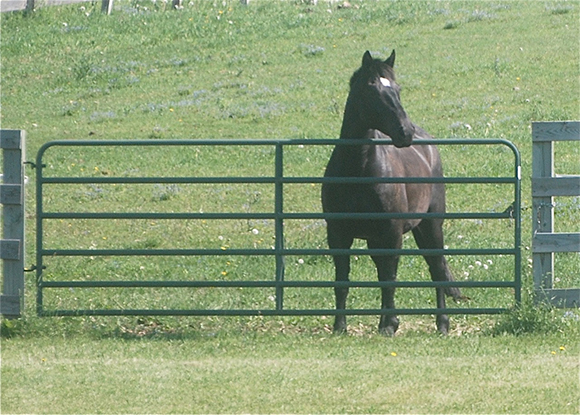The Key to Success ~
Dressage Schooling Based on Your Horse’s Temperament and Conformation ~
Part 1 Conformation

How often have you heard treat your horse as an individual? I suspect fairly often. What does this actually mean?
A world of dressage training expertise and successful experience in making a finished dressage horse is required before changing up the dressage training pyramid. However, riders of every level can be cognizant of the basic facts that affect dressage training of their horse based on its inherent temperament and conformation and school accordingly. I am not suggesting that the training pyramid be ignored or changed up in a vast way, just mildly adjusted to help your horse through the process working carefully with him as an individual. Your training focus will be positioned to still maintain the correct classical edicts, but you will also position your exercises and direction to help your horse succeed.
This will require marrying exercises together, introducing certain exercises earlier than the pyramid might suggest and working your horse with emphasis on certain exercises. Before you break the rules it is imperative you understand them and can execute them.
There are many factors to consider: Breed; Temperament; Conformation; Age. Your horse may exhibit a combination of weaknesses in one or across all areas that mean you need to think and train in an especially smart manner.
Here are a few tips to guide you across that diagonal that is the learning curve as a trainer. For the purposes of this article we will assume that you already know the basics of dressage training and can execute the logic of the U.S.D.F. guidelines and training pyramid and in this part one of two articles we will discover how conformation of your horse will direct your dressage schooling exercises and program. In part two in the next issue we will address the temperament of your horse.

Conformation and temperament are to some degree governed by breed. When you are selecting a dressage prospect you will hopefully try and make the dressage career of your horse as successful and straightforward as possible by understanding that certain breeds are literally bred for the dressage market while others are not. Of course, any horse can benefit from correct dressage training and when you have a horse you decide you want to take into the dressage arena from a different discipline, a horse that is not ‘branded’ for dressage, do not be perturbed. I speak from some experience and have made F.E.I. level horses from many breeds including Quarterhorses, Thoroughbreds, Arabians to name just a few of the lesser favored dressage breeds.
Stick Your Neck Out
You can never consider the pros and cons of any one conformational area of a horse without looking at the entire beast. The importance of the neck length and muscling affects how the horse will connect to the bridle and how he will be able to properly utilize his back. Will he have carrying power, sitting power and the ability to develop the correct neck muscles to be truly to the bit and supple both laterally and longitudinally? A horse with a less than perfect neck for dressage may still make up to a super dressage mount if the rest of the conformation has strengths for dressage.
The horse with a long neck will need to worked forward and down. Do not confuse this with on the forehand. His neck must be stretched and then brought back up to help the nuchal ligament development and this process must be completed slowly. Gradually increase the forward and down time and use soft half halts to bring the horse up and into self-carriage. The horse must carry itself and must not be allowed to lean on the reins. Horses with longer necks will attempt this more than horses with shorter necks. As you develop the horse’s neck you want to see more even width from wither to poll when looking from the saddle. From the ground look for muscle on the top of the neck developing from the wither forward not the poll backward. Horses with long necks will have more trouble with correct transitions and using their backs to engage their cores, so frequent kind work is required to develop the neck to be beneficial for the demands of dressage.
Contact with the bit requires that the horse’s frame becomes shorter and there is an element of elastic tension required. This connection when ridden correctly happens as the horse engages his hindquarters and he is activating all his muscles from his hock to his poll. A horse with a longer neck will therefore find this easier than a horse with a short neck.
The shorter necked horse will have a tendency to lock up. For these horses you need to ride frequent transitions and half halts but you need to work them more in circles and versions thereof such as voltes and figure eights and then on to lateral flexion exercises such as shoulder in/renvers and travers. The reason? It prevents the horse from coming behind the vertical and from locking up in his connection to the bridle. To stretch the horse and encourage him to use his topline properly, work with poles and cavalletti.
Draft influenced breeds have a tendency to shorter necks and often have deep shoulders and their pelvis is often tilted to enable them to push rather than carry. When schooling horses with a shorter neck I introduce lateral work earlier in their program to encourage correct use of their topline. Breeds such as the Andalusian and Lipizzaner can also have a tendency to be well built in the shoulders which can result in tightness and make it difficult for them to free their front ends. For horses who are extremely heavy set in the front end with shorter necks I will introduce the double bridle slightly earlier than the classicists would suggest. I do this for very brief periods of time as a way to show the horse that he can elevate his front end and free his shoulder. This is not to say he is pulled from front to back and into a frame, it is merely a manner to educate him by making him aware that he has the option to sit up in the front and to carry himself freely. This must never be undertaken until he is solid to the snaffle bridle and can stay forward, straight and actively engaged from behind in complete relaxation and must only be conducted by an educated rider with a good seat and soft hands.
There are also types of neck that fall into swan, knife or ewe necks. For those with the knife neck I do not agree with working the horse too low and forward as they will often fake the bit connection and the elements of the training scale of contact and rhythm will be affected. A trained eye/seat is needed here. For these horses I would rather see them elevated in the wither and freeing their shoulders by working them a little bit deeper and more round than too stretched out and perfectly in front of the vertical faking the correct connection. And I do not mean rollkur! For that in my opinion, is the bane of the dressage world. The work I suggest is to supple the horse by flexing the bow and his nose may be behind the vertical as he gains strength but only to a minimal degree.
Some breed registries promote the swan neck and it is common in warmbloods and Friesians and goes together with the long neck. You do not want to encourage a horse to concertina its neck muscles through the upper vertebrae to fake a connection to the bit. So once again you will use the long and low training of the pyramid. The horse with the ewe neck will have trouble maintaining balance and connection with the rider aboard. It is a very difficult task to modify the neck development to aid in the use of the horse’s back and carrying abilities for a dressage horse. For both these issues I would indicate longing the horse in side reins that are adjusted to a length that allow the horse to engage his back and still stretch forward and down. I am not an advocate of draw reins in any scenario but the use of the Vienna rein can also be very beneficial.
Basics of the Back
You might think a horse with a short back will be clever at collecting. Breeds such as the Andalusian and Lusitano may be bred to work in great apparent collection for their original task of herding livestock. Many riders are easily fooled into mistaking rigid, stiff short-coupled backs as being an easy road to trot into the world collection. For the dressage horse it is imperative that the back operate actively and that the core of the horse (which is just important as your own core in riding), is free of tension and is actively operating at all times.
Aside from the lack of space for the saddle (and the high likelihood this horse may also be higher in the croup than perfectly desired for dressage, making saddle fit even harder), this horse needs a rider with especially soft and giving hands to encourage him to work in his own self carriage and feel the freedom to reach for the bit. The telltale sign for incorrect riding of this horse will be a broken muscle line at the 3rd/4th vertebrae. This will be a result of coming behind the vertical as their necks hold the tension that their tight backs have created. This horse must always be ridden brightly forward and of course as any horse, must not be rushed off its feet. Working the horse in a free canter and lots and lots of lateral work will be the road forward with this type of horse. Poles are again a useful tool but gradually increase the distance between them so your horse stretches confidently more forward and learns to release the neck.
The opposite type of back, one that is long is going to require keen attention to keep those hind legs centered and forward of the horse’s croup throughout all gaits. The hind legs will inevitably have a tendency to lag behind. Hopefully if you have a horse with a long back he does not also have a flat croup. If the croup does not have enough angle the horse will find it very difficult to step under himself for dressage and will become what is known as a leg mover. This does not mean he cannot be a successful dressage horse it just makes his life harder.
For the horse with the long back the rider must execute big soft circles with a lot of leg, especially the inside leg to create energy. The challenge with these horses is their innate ability to swing their hindquarters to the outside so an active outside leg is also much needed. I like to work these horses with outside flexion during their routines to encourage the outside leg (which of course then becomes the inside of the horse) to be active and available and ‘in your pocket’ at all times. It is important to constantly cross check the horse with changes of flexion both on the straight line and on the circle to ensure the horse is active and is engaging both hind legs. This is actually a very good exercise for all horses and especially useful for hot horses but more on that in part two of this series. To encourage engagement the half halt will be needed frequently on a long backed horse as a reminder to come forward of the leg. The rider must use approximately double the number of half halts within the gait on a long backed horse than on one perfectly built for dressage to help the horse stay in balance.
These half halts will be more connecting than collecting i.e. they will be held slightly longer to be a connecting half halt. Hold them for three or four seconds instead of the frequent quick one second half halt of advanced collection.

The issues with the horse’s hind end straggling behind will also be apparent with a croup high horse. Extremely high croups will hinder a horse from achieving the top levels of the sport however willing they may be to perform. Height and angle of hock factor in here and the better the conformation below the hip and the hip angle the better shot this horse has of attaining the top reaches of the sport. Remember that horses with sickle hocks will have a tendency to lameness and back soreness. Throughness will be an issue and must be constantly monitored. The best exercises to improve overall throughness are always lateral ones so once again marry lateral work in early to your training regime.
If your horse has a high croup then as he ages he will have a tendency to develop a sway back. These horses will be more leg moving behind than back moving over the topline so to develop their hock strength and maintain soundness work with shoulder in and shoulder fore frequently in all gaits. Horses with high croups will have a tendency to become sore in the stifles and sacroiliac joint. For the very top levels of dressage the horse with an extremely high croup is not likely to stay sound. While might attain the movements under a skilled rider and score well, it will come at the expense of his well-being.
The shape of the horse’s back is also important for dressage and it needs to be supple and strong. Preferably your horse will have some downward curvature from wither to the tail. If your horse has excessive curvature in his back you must guard against him hollowing his back. This means you will consistently need to work him over his back in a bascule to develop the rippling muscle power he needs to concertina himself in collection. Working the horse in counter flexion, over poles and cavalletti and travers/renvers will keep his back elastic.
My Horse the Basketball Player
Do not succumb to the taller is better ethic. Bigger horses take a lot longer to develop and will find exercises at the basic levels harder because of their coordination issues and their abilities to stay active on the smaller circles and arenas. There is a lot more horse mass to orchestrate and the physical movement in every step is magnified so the rider needs to have a very independent and soft seat to facilitate all this movement being allowed to move from back to front in a giant wave across the horse’s topline.
This horse must be worked on larger and softer curves e.g. when making a centerline allow the semi circle to start earlier and graduate the corner more gently.
Because the taller/larger horse has more muscle mass it is imperative that the warm up and cool down phase be extended. The horse simply has more body to work and so start him off gently at the walk, progress to trot and start on larger circles and serpentines to allow the horse time to access all his parts.
With the larger horse it is also very important that the rider train the horse to work with minimal and quiet aids. This horse will quickly become a physically strong adversary if incorrectly trained and must be trained to go promptly forward off the leg and in self-carriage.
All horses benefit from the gymnasticizing exercises of dressage and frequent correctly executed transitions both between and within gaits, in addition to half halts and school figures and movements. While there are many other factors to consider in comformation for training such as hock angles, femur length, head neck connection and more, these are beyond the scope of this article.
The conformation of your horse will also affect his temperament as it will define how he moves and how easy he finds the tasks you set for him. So when schooling your horse you must also take into consideration not just how he moves but also how he mentally handles his body. Please see part two in this series in the next issue to learn how to school your hot, lazy, independent, hyperactive, fearless or fearful horse. We will also address how gender can affect temperament and training and discuss methods to successfully train stallions, mares and geldings.
Happy riding!


